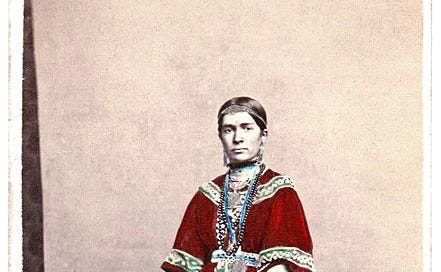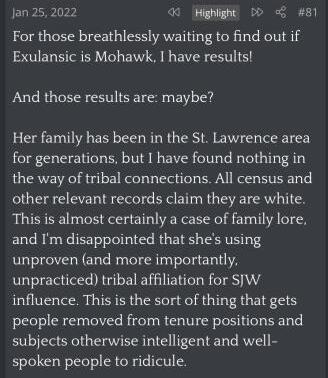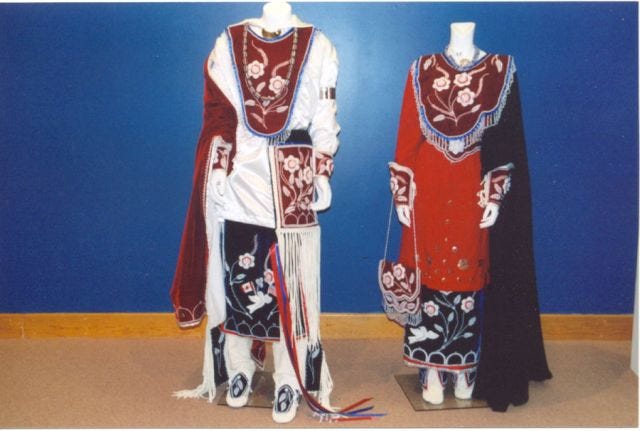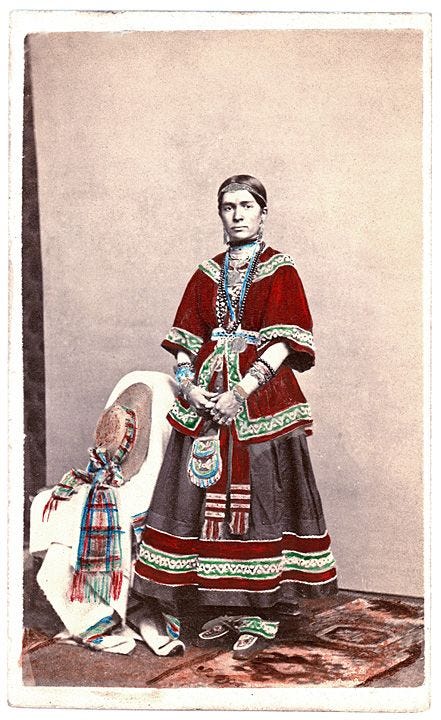As stateed previously, please read or listen to Dr. Saliha Belmessous’ essay, Assimilation and Racialism in Seventeenth and Eighteenth Century French Colonial Policy, to put my identity in the proper context.
I will discuss the French-Native m/Métis, which by convention refers to the French-Native mixed generally in the lower case, and a specific population of French-Native métis people when capitalized. Like mestiza, which refers to the children of Spanish-Native intermarriage etc., métis means mixed.
Beginning in 1670, the Hudson’s Bay Company (HBC) held legal control over all lands whose waters drained into Hudson Bay. Known as Rupert’s Land, this territory included all of present-day Manitoba. The HBC’s policies in the region included limiting the number of white migrants who could settle in the area. The Métis population, as a result, became predominant. The Métis were the offspring of European fur traders — mostly French, Scottish and Irish — and local Indigenous people. By 1870, the Métis population in the Red River Valley was estimated at 10,000 people.
https://www.thecanadianencyclopedia.ca/en/article/manitoba-act
I live in Rupert’s land to this day. I made it portable.
Métis are a recognized ethnic group that did not exist prior to colonization and came into existence via the merger of other pre-existing ethnic groups and subsequent stigmatization, racialization, and social marginalization of their mixed descendants. Métis does not imply a particular blood quantum or a particular tribe from which the mixture was derived, but it does imply being related to several branches of people in New France in the 1600s.
My family history is that we are specifically French Mohawk. This comports with the region of the country the same commenter acknowledges we have lived for generations. Due to French colonial policy and the realities of being a beaver trapper - yes, the jokes write themselves - there are a lot of French-Native métis throughout the United States and Canada. Due to cultural values, we apparently got along well with Irish immigrants fleeing British colonization in the 19th century, and later 20th century Italian immigrants, and so their children, including me, became even more métis.
This is what the Métis flag looks like, which has existed longer than the Canadian flag:
My detractors who fixate on this facet of me, which is a motivating force behind my feminist activism but is otherwise largely unrelated to my work on trans surgeries, are people who do not understand or have some other objection to the concept of a Native métis person. They inherited a perspective bent on discouraging people like me from keeping our cultures alive, for economic reasons. They have assigned me their external racial category designation, and it is expected that I will conform. This has been their goal for centuries: elimination of Native cultures.
The objection, which may not be voiced, is that we think of ourselves as being and belonging to more than the sum of our parent cultures. We do not see our heritage as incomplete. We do not see our claim to the parent cultures as partial. They object to the fact that we embrace a name for our distinct cultural values and that we make equal claim to all contributions of all ancestors, as well as the lessons gleaned from the merger itself, the second tongue of biculturalism. One thing to understand about métis is that it is not a word mothers taught their children until long after the mixture had been occurring, nor does every mixed Native person identify with this word or even know this word. And yet, it applies.
There is somehow controversy as to the existence of “eastern métis,” as though there would not have been mixing until they got past the Great Lakes despite the fact that metissage was officially encouraged and expected by the colonial authority, as a colonization strategy, and despite the relative lack of French women. They would have you believe the French arrived thirstless, and it was only once they got a ways inland that they started looking for a warm bed. Please! See Dr. Belmessous’ article as to whether there was a New France assimilation project in Quebec, specifically, in the 1600s.
Quebec was founded in 1608, and not by Spain or Britain. French colonial policy did not exempt Quebec. Having a word for ourselves, especially the word mixed, is earned and is necessary. The thought of attempting to assert treaty rights due to being mixed is clearly absurd and those suggesting that as a motive are disingenuous - as absurd as the idea that I would only call myself Danish in some attempt to get on the public dole in Denmark. I question who is behind this effort as it is plainly in service of stigmatizing mixed descendants as foolish, greedy, and deceitful. This has been a longstanding political project in the United States and Canada for some time.
I do not believe being mixed gives me any special tribal or treaty rights as I am not a member of any tribe - in other words, possessing of dual citizenship in a sovereign government - and am therefore not a party to any treaty. However, it would be fully within the sovereign right of any tribe to make me a member, no matter what my ancestry is, because they are separate governments which are entitled to do that. (DMs are open!)
Yet I am mixed with bequeathed heritage. I am my mother’s daughter. I am a part of my own lineage, and no generations were skipped between my “one native ancestor long ago” as I’ve seen some confused people put it, and now. And if you go back before the mix, we were Iroquois, and therefore we continue to be that, and are likely many more things as the Iroquois adopted people, often over their objections.
This quote illustrates why I question whether this is grass or astroturf, in the article questioning the reality of métis people at the point of arrival for male French colonists looking for wives
'There was no such thing'
Many critics reject outright that there is a distinct Métis identity in the Maritimes and Quebec.
People of mixed blood in the region either integrated into Indigenous communities or assimilated with European newcomers, unlike the distinct Metis People of Louis Riel in Western Canada.
Who somehow didn’t assimilate with European newcomers, even though that’s why they’re métis.
There was no such thing, because the no-such-things, acknowledged to exist, gave up their culture. No take-backs! Snuck right in there is the idea that if you are integrated into white or Native society - presumed separate - whether by choice or by adoption, you have given up any claim of being mixed. You are no longer your mother’s child. No remixes allowed! That would be Indian-giving. And we can’t have that because, as Dr. Belmessous explains, consciousness of Native identity is a key factor in cultural survival.
You have to believe in it, to know it is worth having, to pass it on to the next generation. Rather than be proudly remixed, they want to cut us down by slicing alleged rough edges and burning off so-called impurities until we fit in the pantry, frozen in time until needed for entertainment. The goal is to make us smaller and weaker, those who refuse to relinquish our cultural beliefs, attitudes, practices, and identity. That has always been the goal. Our self-awareness as remixes makes us politically grander, not smaller.
This individual did some research into my lineage, focusing on my grandmothers, perhaps due to an incomplete understanding of our matrilineal kinship system, a lot of assumptions, and a disingenuous conflation of lineage with citizenship.
The comment reads:
That’s the end of the comment. This person confirmed my family history as accurately represented, then called it “lore” - as though his family history is something else, as though he had genetic tests proving his family lore regarding his more than 16,000 ancestors in the 1600s, barring inbreeding. He suggests that no reasonable person - i.e., me, or my family - could have reviewed these records and come to a different conclusion - perhaps because we have been burdened by education. Therefore, their conclusion, their bullshit attempts to chase fake ancestry for clout, via smearing my coattails, somehow proves I have not done due diligence, nor has anyone in my family. Quite a conclusion to come to, and all because I had the audacity to identify myself.
In this series of essays, I hope to reveal that those individuals who would subject another person to ridicule over their ethnicity - who seek out métis, mestiza and the mixed, specifically - are simply the contemporary extension of a political project with roots in French colonial policy. They pretend to be on the side of Natives when doing this, white knighting for those with tribal cards, but in fact it does not serve Native interests to stigmatize mixed descendants and to discourage consciousness of Native identity, anymore than it serves women to attack our political class consciousness as women by attacking the definition of woman and persuading some women that they are really men and that some men are women.
The reverse one-drop rule of blood quantum logic is and always has been rooted in racism and racialist assimilationism. I am a product of official assimilation policy, and these shades of gray are too complex for some to cope with. There is a fundamental disappointment when they learn that I am not the Indian in the Cupboard, wearing an 18th century costume, ready to build them a longhouse, by myself, before going back to my proper time. Instead, I am a mudblood, of questionable pedigree. Little Bear, the character from The Indian in the Cupboard, is canonically Iroquois.

The word “Iroquois” began its life as a slur that derives from the Frenchification of the Huron tribe’s word for them, which translated to snake. The Huron did not like the Iroquois. The Iroquois word for Iroquois is Haudenosaunee, which means People of the Longhouse. The longhouse was the literal traditional housing as well as the “long house” of the Haudenosaunee Confederacy. The Haudenosaunee Confederacy, according to some researchers, dates back to as early as 1142, and may have been inspired in part by a solar eclipse. The story goes that the Great Peacemaker and Hiowatha convinced the tribes to unite. Jigonhsasee, the “mother of nations” accepted the great Peacemaker’s vision of peace first, and therefore clan mothers were given control, which is reasonable as women live much longer and are the source of society.
I am not Little Bear, nor am I his clan mother. Who would bring me to show-and-tell?
Quebec was founded in 1608. There were approximately 14 generations between 1625 and now, if we assume 25 years is one generation. Though sometimes, a generation is 15 years and other times, a generation is 35 years. But taking 25 as a rough estimate, that means that in 1625, my direct ancestors totaled 2^14, or 16,384 people who were alive at about the same time, barring inbreeding, again. Some of those ancestors were still in Italy and Scandinavia, but “several branches” (lets say 1/4th, or 4096 direct ancestors of the relevant grandparent) were in Quebec, where Native and French métissage - miscegenation - was rampant and officially encouraged.
The first 4 generations of French immigrants were, per historical records, approximately 12,700 males, with only 1,700 females. This is exclusive of nuns, who were not marrying or reproducing (Dr. Belmessous, 2005). They came alone and married Native women when they arrived. They did so with full approval and encouragement from the French government. France was trying to Johnny Appleseed the continent to expand the empire. The French government “did not wish to depopulate France to populate New France,” as Dr. Belmessous explains in her article There was no concept of race nor racial stigma yet to discourage intermarriage. Mixed offspring were not yet seen as other, and Frenchness would naturally overpower Nativeness and lead to French children - as long as it was a French father.
Centuries later, when the handcart Mormons arrived, they did not intermarry with Natives, because the handcart Mormons, like the British on the Mayflower and unlike the French beaver trappers, came over as entire families. There was no sex imbalance-based need for the Mormon men to take Native wives in 1850. Further, the Native population by that point was much smaller. It was a very different historical context.
In New France, French male trappers and Native women were intermarrying in Mohawk country for centuries, with other contributions depending on unrecorded circumstances such as mourning wars-related adoptions. Good luck attempting to blood quantum that. It was always a lie aimed at undermining tribal sovereignty.
The top border of this map is the referenced St. Lawrence River, feeding into Lake Ontario. I made a trip up there when I went to NY to see a panel Posie Parker was speaking on in March 2022.
This map shows that Mohawk are the easternmost nation of the original 5-nation Iroquois Confederacy - the “keepers of the Eastern door” - and are represented as the furthest icon on the flag on the right. The other original nations are (left to right): Seneca, Cayuga, Onondaga, and Oneida. This flag was adopted in 1980, and is based on the design on Hiawatha’s belt, which dates back from at least the 16th century. Hiawatha was a famous orator who accompanied the Great Peacemaker in bringing peace to the warring tribes to found the Haudenosaunee Confederacy.
My purpose in linking to Dr. Belmessous’ essay, and then writing this series, is to educate as to the complexity of Native identity via a specific cross-sectional and longitudinal community case study, as well as to reveal the machinations of assimilation and its legacy. I hope to illuminate the double standards that those who discuss their Nativeness are subject to, especially those of us with a mixed “racial” background - and I place racial in quotes to problematize the concept as it relates to New France. The logic that mixed descendants are lesser members of their mother’s culture is the logic that gives rise to rape as a weapon of war. In this case, it was the cold war of assimilation policy - a war we are still fighting to this day to keep our cultures alive.
Race-conscious critics must to learn to cope with the complexity of contemporary Native identity. It is not my job to educate them, though. It is just my pleasure.























Share this post